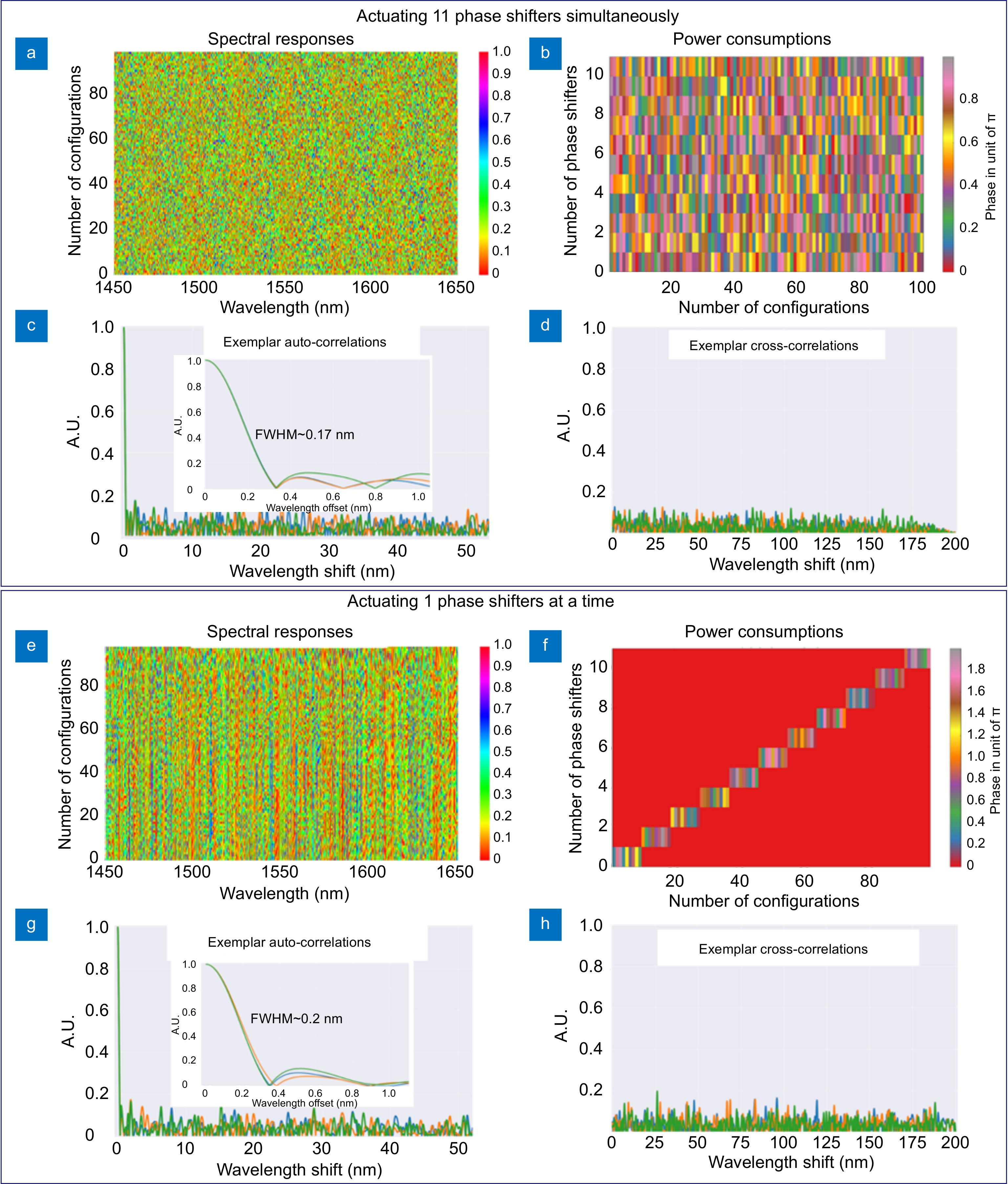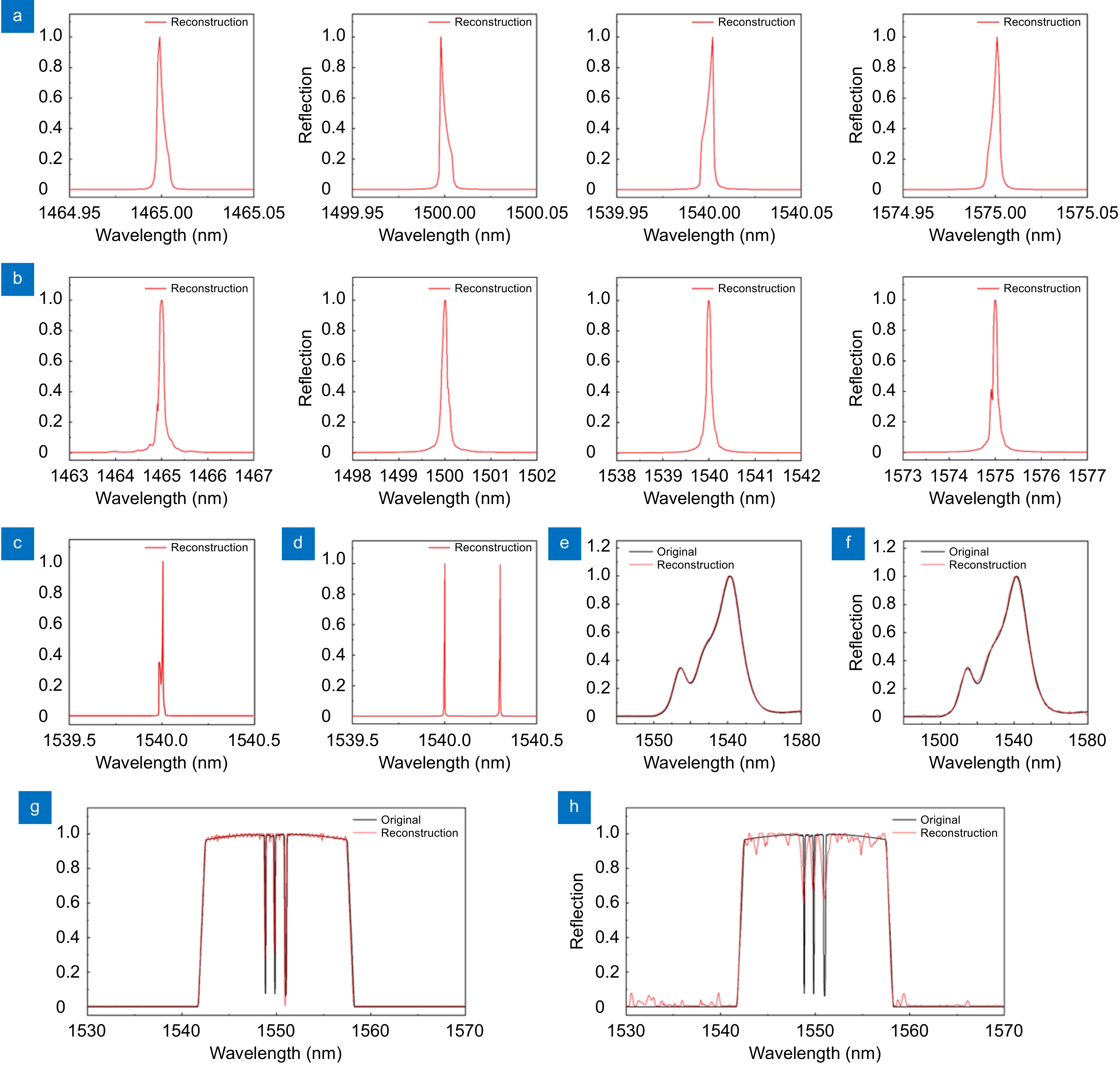| Citation: | Li A, Wu YF, Wang C et al. An inversely designed integrated spectrometer with reconfigurable performance and ultra-low power consumption. Opto-Electron Adv 7, 240099 (2024). doi: 10.29026/oea.2024.240099 |
An inversely designed integrated spectrometer with reconfigurable performance and ultra-low power consumption
-
Abstract
Despite the pressing demand for integrated spectrometers, a solution that deliver high-performance while being practically operated is still missing. Furthermore, current integrated spectrometers lack reconfigurability in their performance, which is highly desirable for dynamic working scenarios. This study presents a viable solution by demonstrating a user-friendly, reconfigurable spectrometer on silicon. At the core of this innovative spectrometer is a programmable photonic circuit capable of exhibiting diverse spectral responses, which can be significantly adjusted using on-chip phase shifters. The distinguishing feature of our spectrometer lies in its inverse design approach, facilitating effortless control and efficient manipulation of the programmable circuit. By eliminating the need for intricate configuration, our design reduces power consumption and mitigates control complexity. Additionally, our reconfigurable spectrometer offers two distinct operating conditions. In the Ultra-High-Performance mode, it is activated by multiple phase-shifters and achieves exceptional spectral resolution in the picometer scale while maintaining broad bandwidth. On the other hand, the Ease-of-Use mode further simplifies the control logic and reduces power consumption by actuating a single-phase shifter. Although this mode provides a slightly degraded spectral resolution of approximately 0.3 nm, it prioritizes ease of use and is well-suited for applications where ultra-fine spectral reconstruction is not a primary requirement. -

-
References
[1] Yang ZY, Albrow-Owen T, Cai WW et al. Miniaturization of optical spectrometers. Science 371, eabe0722 (2021). doi: 10.1126/science.abe0722 [2] Li A, Yao CH, Xia JF et al. Advances in cost-effective integrated spectrometers. Light Sci Appl 11, 174 (2022). doi: 10.1038/s41377-022-00853-1 [3] Chen C, Li XY, Yang G et al. Computational hyperspectral devices based on quasi-random metasurface supercells. Nanoscale 15, 8854–8862 (2023). doi: 10.1039/D3NR00884C [4] Seyringer D, Sagmeister M, Maese-Novo A et al. Compact and high-resolution 256-channel silicon nitride based AWG-spectrometer for OCT on a chip. In 2019 21st International Conference on Transparent Optical Networks (ICTON) 1–4 (IEEE, 2019); http://doi.org/10.1109/ICTON.2019.8840473. [5] Gatkine P, Veilleux S, Hu YW et al. Arrayed waveguide grating spectrometers for astronomical applications: new results. Opt Express 25, 17918–17935 (2017). doi: 10.1364/OE.25.017918 [6] Xia ZX, Eftekhar AA, Soltani M et al. High resolution on-chip spectroscopy based on miniaturized microdonut resonators. Opt Express 19, 12356–12364 (2011). doi: 10.1364/OE.19.012356 [7] Redding B, Liew SF, Sarma R et al. Compact spectrometer based on a disordered photonic chip. Nat Photonics 7, 746–751 (2013). doi: 10.1038/nphoton.2013.190 [8] Ma KQ, Chen KX, Zhu N et al. High-resolution compact on-chip spectrometer based on an echelle grating with densely packed waveguide array. IEEE Photonics J 11, 4900107 (2019). [9] Li A, Wang C, Bao FX et al. An integrated single-shot spectrometer with large bandwidth-resolution ratio and wide operation temperature range. PhotoniX 4, 29 (2023). doi: 10.1186/s43074-023-00109-0 [10] Li A, Fainman Y. On-chip spectrometers using stratified waveguide filters. Nat Commun 12, 2704 (2021). doi: 10.1038/s41467-021-23001-6 [11] Wang Z, Yi S, Chen A et al. Single-shot on-chip spectral sensors based on photonic crystal slabs. Nat Commun 10, 1020 (2019). doi: 10.1038/s41467-019-08994-5 [12] Redding B, Liew SF, Bromberg Y et al. Evanescently coupled multimode spiral spectrometer. Optica 3, 956–962 (2016). doi: 10.1364/OPTICA.3.000956 [13] Gao H, Fan XH, Wang YX et al. Multi-foci metalens for spectra and polarization ellipticity recognition and reconstruction. Opto-Electron Sci 2, 220026 (2023). doi: 10.29026/oes.2023.220026 [14] Zheng ZH, Zhu SK, Chen Y et al. Towards integrated mode-division demultiplexing spectrometer by deep learning. Opto-Electron Sci 1, 220012 (2022). doi: 10.29026/oes.2022.220012 [15] Dong P, Qian W, Liang H et al. Thermally tunable silicon racetrack resonators with ultralow tuning power. Opt Express 18, 20298–20304 (2010). doi: 10.1364/OE.18.020298 [16] Xu HN, Qin Y, Hu GL et al. Breaking the resolution-bandwidth limit of chip-scale spectrometry by harnessing a dispersion-engineered photonic molecule. Light Sci Appl 12, 64 (2023). doi: 10.1038/s41377-023-01102-9 [17] Sun CL, Chen ZQ, Ye YT et al. Scalable on‐chip microdisk resonator spectrometer. Laser Photonics Rev 17, 2200792 (2023). doi: 10.1002/lpor.202200792 [18] Souza MCMM, Grieco A, Frateschi NC et al. Fourier transform spectrometer on silicon with thermo-optic non-linearity and dispersion correction. Nat Commun 9, 665 (2018). doi: 10.1038/s41467-018-03004-6 [19] Li A, Fainman Y. Integrated silicon fourier transform spectrometer with broad bandwidth and ultra-high resolution. Laser Photonics Rev 15, 2000358 (2021). doi: 10.1002/lpor.202000358 [20] Zheng SN, Zou J, Cai H et al. Microring resonator-assisted Fourier transform spectrometer with enhanced resolution and large bandwidth in single chip solution. Nat Commun 10, 2349 (2019). doi: 10.1038/s41467-019-10282-1 [21] Kita DM, Miranda B, Favela D et al. High-performance and scalable on-chip digital Fourier transform spectroscopy. Nat Commun 9, 4405 (2018). doi: 10.1038/s41467-018-06773-2 [22] Yao CH, Chen MJ, Yan T et al. Broadband picometer-scale resolution on-chip spectrometer with reconfigurable photonics. Light Sci Appl 12, 156 (2023). doi: 10.1038/s41377-023-01195-2 [23] Zhang L, Zhang M, Chen TN et al. Ultrahigh-resolution on-chip spectrometer with silicon photonic resonators. Opto-Electron Adv 5, 210100 (2022). doi: 10.29026/oea.2022.210100 [24] Krishna RM, Eftekhar A, Lee S et al. Polysilicon micro-heaters for resonance tuning in CMOS photonics. Opt Lett 47, 1097–1100 (2022). doi: 10.1364/OL.441510 [25] Xu HN, Qin Y, Hu GL et al. Scalable integrated two-dimensional Fourier-transform spectrometry. Nat Commun 15, 436 (2024). doi: 10.1038/s41467-023-44518-y [26] Li K, Yang M, Cai CK et al. Handling mode and polarization in fiber by fs-laser inscribed (de)multiplexer and silicon switch array. PhotoniX 4, 14 (2023). doi: 10.1186/s43074-023-00093-5 [27] Gao L, Qu YR, Wang LH et al. Computational spectrometers enabled by nanophotonics and deep learning. Nanophotonics 11, 2507–2529 (2022). doi: 10.1515/nanoph-2021-0636 [28] Bogaerts W, Pérez D, Capmany J et al. Programmable photonic circuits. Nature 586, 207–216 (2020). doi: 10.1038/s41586-020-2764-0 [29] Xie YW, Hong SH, Yan H et al. Low-loss chip-scale programmable silicon photonic processor. Opto-Electron Adv 6, 220030 (2023). doi: 10.29026/oea.2023.220030 [30] Wang N, Yan W, Qu YR et al. Intelligent designs in nanophotonics: from optimization towards inverse creation. PhotoniX 2, 22 (2021). doi: 10.1186/s43074-021-00044-y [31] Zagaglia L, Floris F, O'Brien PA. Experimental characterization of particle swarm optimized focusing non-uniform grating coupler for multiple SOI thicknesses. J Lightwave Technol 39, 5028–5034 (2021). doi: 10.1109/JLT.2021.3079575 [32] Fu PH, Chao CY, Huang DW. Ultracompact silicon waveguide bends designed using a particle swarm optimization algorithm. IEEE Photonics J 13, 6600509 (2021). doi: 10.1109/JPHOT.2020.3043828 [33] Chen WW, Li HX, Zhang BH et al. Silicon mode (de) multiplexer based on cascaded particle-swarm-optimized counter-tapered couplers. IEEE Photonics J 13, 6600210 (2021). doi: 10.1109/JPHOT.2020.3046361 [34] Mak JCC, Sideris C, Jeong J et al. Binary particle swarm optimized 2× 2 power splitters in a standard foundry silicon photonic platform. Opt Lett 41, 3868–3871 (2016). doi: 10.1364/OL.41.003868 [35] Abedi K, Mirjalili SM. Slow light performance enhancement of Bragg slot photonic crystal waveguide with particle swarm optimization algorithm. Opt Commun 339, 7–13 (2015). doi: 10.1016/j.optcom.2014.11.035 [36] Djavid M, Mirtaheri SA, Abrishamian MS. Photonic crystal notch-filter design using particle swarm optimization theory and finite-difference time-domain analysis. J Opt Soc Am B 26, 849–853 (2009). doi: 10.1364/JOSAB.26.000849 -
Access History

Article Metrics
-
Figure 1.
A few examples of different types of integrated spectrometers. (a) Passive spectrometer utilizing an array of stratified waveguide filters with distinct spectral responses. (b) Scanning spectrometer based on tunable narrowband filter, e.g. microring resonator. (c, d) Fourier transform spectrometer with continuous optical path delay enabled by thermo-optic effect (c) and switch-array to reconfigure the physical channels (d).
-
Figure 2.
(a) Structure of our proposed programmable circuit. (b) Simulated spectral responses for the inversely designed structure with 0 and π phase changes applied to the 11 phase shifters, respectively. (c) Auto-correlation and cross-correlations of the spectral responses of the inversely designed circuit. (d) Simulated spectral responses for the randomly designed structure with 0 and π phase changes applied to the 11 phase shifters, respectively. (e) Auto-correlation and cross-correlations of the spectral responses of the randomly designed circuit.
-
Figure 3.
(a−d) Simulations when actuating 11 phase shifters simultaneously. (a) Simulated spectral responses under 100 different configurations of 11 phase shifters. (b) Phase changes of the 11 phase shifters. (c) Exemplar auto-correlations of those spectral responses. (d) Exemplar cross-correlations between several spectral responses. (e−h) Simulations when actuating single phase shifter at a time. (e) Simulated spectral responses under 100 different configurations of all 11 phase shifters. (f) Phase changes of the 11 phase shifters. (g) Exemplar auto-correlations of those spectral responses. (h) Exemplar cross-correlations between several spectral responses.
-
Figure 4.
(a) Images of the fabricated chip. (b–e) Experimental results when actuating 11 phase shifters simultaneously. (b) Spectral responses under 400 different configurations of 11 phase shifters. (c) Power consumptions of the 11 phase shifters. (d) Exemplar auto-correlations of those spectral responses. (e) Exemplar cross-correlations between several spectral responses.
-
Figure 5.
Experimental results when actuating 1 phase shifters at a time. (a) Spectral responses under 132 different configurations of all 11 phase shifters. (b) Power consumptions of the 11 phase shifters. (c) Exemplar auto-correlations of those spectral responses. (d) Exemplar cross-correlations between several spectral responses.
-
Figure 6.
Reconstructions of various narrow peaks when the spectrometer working at mode 1 (a) and mode 2 (b), with a resolution of 6 pm and 150 pm, respectively. Reconstructions of two closely standing narrow peaks when the spectrometer working at mode 1 (c) and mode 2 (d), with a minimum distance of 15 pm and 300 pm, respectively. Reconstructions of broad spectrum when the spectrometer working at mode 1 (e) and mode 2 (f). Reconstructions of a complex dense spectrum when the spectrometer working at mode 1 (g) and mode 2 (h).

 E-mail Alert
E-mail Alert RSS
RSS



 DownLoad:
DownLoad:







